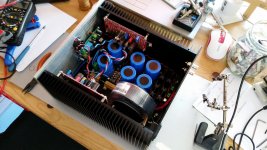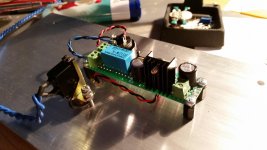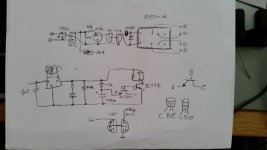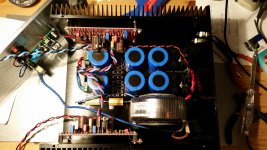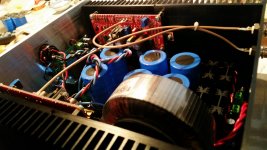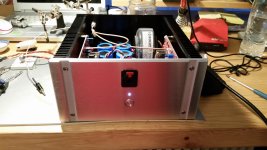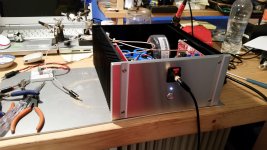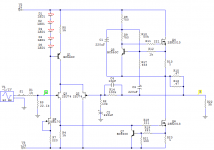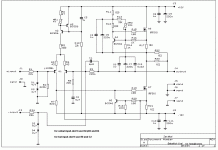CCS , if good enough , is good enough
though , if you connect Gigaohm resistor to God's Eye potential , that one would be better
even if no one could hear difference

though , if you connect Gigaohm resistor to God's Eye potential , that one would be better
even if no one could hear difference

Yup, the circuit is taken from the DCB1 pre. The relay keeps the output shorted to ground a couple of seconds during startup and quickly shorts it to ground again during shutdown.
jwb is using a similar circuit in http://www.diyaudio.com/forums/headphone-systems/22817-jwbs-ultimate-aleph-headphone-amp.html
jwb is using a similar circuit in http://www.diyaudio.com/forums/headphone-systems/22817-jwbs-ultimate-aleph-headphone-amp.html
Attachments
Last edited:
A sneak peek of my almost finished Aleph H. PSU is working fine, output delay circuit is confirmed working too. Input wiring and bias procedure are up next.
Looking very nice!
The amp has now logged several hours of operation with a dummy load (35R resitance, see third pic on the left). I biased the output FETs @ 0.5A and set the Aleph current source AC gain to 60%. Output offset is stable at about 0.1V on both sides, which means the headphones have to sink 0.2mW in idle. I will adress this issue at some later point though when I switch to JFET inputs. The rails are @ +17.50 and -17.49 VDC, a bit higher as planned. The heatsinks are properly sized and get comfortably warm.
The current limiter circuitry is in place, so far no smoke has escaped from the FETs.
The amp is driving my HE-400i with great ease and really makes them sing, I'm really satisfied.
The current limiter circuitry is in place, so far no smoke has escaped from the FETs.
The amp is driving my HE-400i with great ease and really makes them sing, I'm really satisfied.
Attachments
> The current limiter circuitry is in place, so far no smoke has escaped from the FETs.
I don't think you got the message.
Aleph-H has negative feedback, probably around 20~30dB.
For any feedback amp, if there is input signal and the output is short circuited, the NFB will keep driving the output devices to deliver more current,
in an attempt to achieve the required output voltage.
The limit in this case is 2x nominal (Vgs + I*Rs), as this is the maximum drive voltage supplied by the input diff pair to the MOSFET gate.
And this "excess" current will be sunk to ground by the relay via the output mosfets.
Not that it is necessarily an issue, as long as your MOSFETs and relay can take it.
But you should be aware what happens when you short circuit outputs.
Patrick
I don't think you got the message.
Aleph-H has negative feedback, probably around 20~30dB.
For any feedback amp, if there is input signal and the output is short circuited, the NFB will keep driving the output devices to deliver more current,
in an attempt to achieve the required output voltage.
The limit in this case is 2x nominal (Vgs + I*Rs), as this is the maximum drive voltage supplied by the input diff pair to the MOSFET gate.
And this "excess" current will be sunk to ground by the relay via the output mosfets.
Not that it is necessarily an issue, as long as your MOSFETs and relay can take it.
But you should be aware what happens when you short circuit outputs.
Patrick
EUVL is right that shorting the output will drive it to the rails. It doesn't matter in my original design; the available current isn't enough to break anything in ten seconds or whatever the startup time is. Think about the voltages and bias current in your design and the FETs and relays you used to check if it's safe.
Measurement revealed that the two parallel 0R47 resistors at the output drop 110mV during a cold startup with a shorted output. This means the current through them equals 0.11/(0.47/2)=0.468A. Should be well within the capabilities of the output stage FETs. The RY12-RK relay can handle 1A@24VDC. Am I missing something?
I'm thinking about building another iteration.
The plan is to replace the CCS Zener with a LED string fed by a 2SK170, put a well matched pair of 2SJ74 in the LTP and use 2SK2013 in the Aleph current source and the output, the latter biased at 500mA.
The plan is to replace the CCS Zener with a LED string fed by a 2SK170, put a well matched pair of 2SJ74 in the LTP and use 2SK2013 in the Aleph current source and the output, the latter biased at 500mA.
Attachments
I am getting back to my old Aleph H. It was packed away for a few years and I feel it is time to revisit and see if I can learn a bit more.
From memory, it sounded best when it was running biased rather high but had an annoying psu-related hum. After reducing the bias and playing around with the psu I got rid of the hum, but from memory some of the magic was gone.
Lately I have been thinking about the Aleph circuit. If I understand correctly it sounds best when the Aleph current source delivers about 50% under load. I assume that (at a given, fixed configuration) the Aleph contribution will be different for a 32R headphone than say a 300R headphone. If that is indeed the case, it could be expected that it sounds better with the load it is optimised for.
Does it make sense to use a fixed resistor (parallel to the load) as a kind of shunt to ensure the amp sees a much smaller change in load when changing headphones?
From memory, it sounded best when it was running biased rather high but had an annoying psu-related hum. After reducing the bias and playing around with the psu I got rid of the hum, but from memory some of the magic was gone.
Lately I have been thinking about the Aleph circuit. If I understand correctly it sounds best when the Aleph current source delivers about 50% under load. I assume that (at a given, fixed configuration) the Aleph contribution will be different for a 32R headphone than say a 300R headphone. If that is indeed the case, it could be expected that it sounds better with the load it is optimised for.
Does it make sense to use a fixed resistor (parallel to the load) as a kind of shunt to ensure the amp sees a much smaller change in load when changing headphones?
why not
also , you can alter AC gain , by will (switch on front , why not)
for cans , best to have regulated rails , or cap-multiplied
also , you can alter AC gain , by will (switch on front , why not)
for cans , best to have regulated rails , or cap-multiplied
What about using a LD1014d for Q6 ? Ok the biasing needed for the LD1014 is a lot different instead of about + 4v as for a Irf610 we would need something like - 2v but we could get that by changing R20 to something larger about 10 ohms might work .
name of the game is having upper part of amplifier sort of current follower (following lower art but antiphase) , without adding own flavor
same applies to Aleph , ACA , or any of last Papa's SE thingies
so , type of device (being driven from pretty low impedance ) isn't so important as choice of lower one
one can try LU as lower OS device , recipe given eons ago by EUVL
(in that instance Mighty Moi being Public Fool , for oomphtienth time )
)
same applies to Aleph , ACA , or any of last Papa's SE thingies
so , type of device (being driven from pretty low impedance ) isn't so important as choice of lower one
one can try LU as lower OS device , recipe given eons ago by EUVL
(in that instance Mighty Moi being Public Fool , for oomphtienth time
 )
)Hello
I think about Aleph H but with j-fet input (like Aleph J)
It is possible?
I have nice matched quadre of 2SJ74...
Zoltan
I think about Aleph H but with j-fet input (like Aleph J)
It is possible?
I have nice matched quadre of 2SJ74...
Zoltan
one can try LU as lower OS device , recipe given eons ago by EUVL
http://www.diyaudio.com/forums/pass-labs/111197-aleph-schematic-6.html#post1358353
http://www.diyaudio.com/forums/pass-labs/111197-aleph-schematic-6.html#post1361918
And you should use the 200mA triode cell of the DAO for headphones.
Patrick
I am thinking of doing an Aleph for my headphones. My speaker Aleph has a bit of DC drift, which would be an issue for headphones. What are your experiences with DC drift in your headphone Alephs?
Also, I have some good old 2SK216 lateral mosfets. Should I use them? Thoughts?
Also, I have some good old 2SK216 lateral mosfets. Should I use them? Thoughts?
- Home
- Amplifiers
- Pass Labs
- Aleph H Schematic - Revealed at Last
